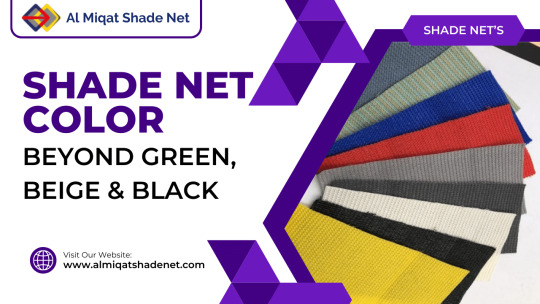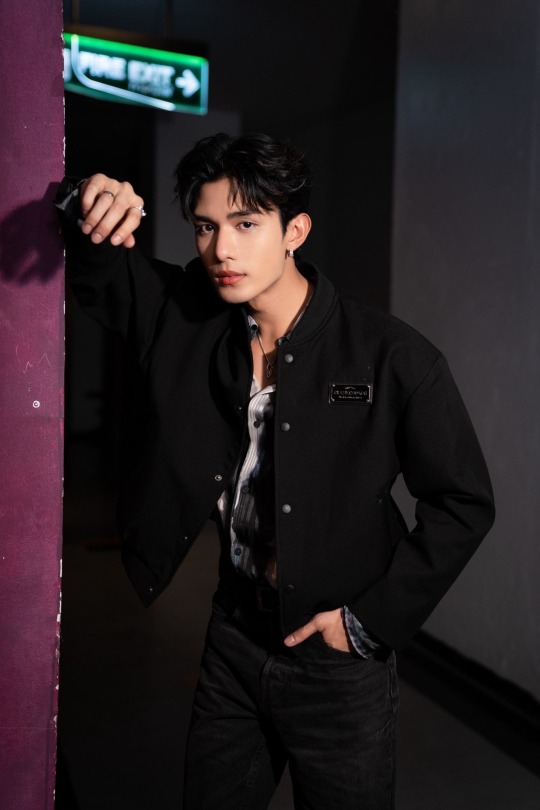#shade netting
Text
1 note
·
View note
Text

1. Material Quality:
UV Stabilization: High-quality monofilament shade nets are typically treated with UV stabilizers to enhance their resistance to degradation from sunlight exposure. UV-stabilized nets are less prone to fading, brittleness, and loss of strength over time.
Durability: The thickness and strength of the monofilament fibers contribute to the overall durability of the shade net. Nets made from high-quality materials with thicker fibers are generally more durable and long-lasting.
2. Environmental Conditions:
Sunlight Exposure: Prolonged exposure to sunlight can accelerate the degradation of shade nets over time, particularly in regions with intense sunlight and high UV radiation levels. Nets installed in sunny climates may experience more rapid deterioration compared to those in shaded or cooler environments.
Temperature Extremes: Extreme temperatures, including both high heat and freezing conditions, can affect the performance and lifespan of shade nets. Thermal expansion and contraction may lead to material fatigue and reduced structural integrity over time.
3. Maintenance Practices:
Cleaning: Regular cleaning of shade nets can help remove dirt, debris, and organic matter that may accumulate on the surface. Accumulated debris can trap moisture and promote the growth of algae, fungi, or moss, which can degrade the net material over time.
Inspections: Periodic inspections allow for the early detection of any signs of damage, wear, or weakening of the shade net. Prompt repairs or replacements of damaged sections can help extend the overall lifespan of the netting.
4. Intended Use:
Tension and Stress: The manner in which the shade net is installed and tensioned can affect its longevity. Improper installation or excessive tensioning may cause premature stretching, tearing, or failure of the net material.
Abrasion and Friction: Nets subjected to friction or abrasion from wind, rubbing against structures, or contact with abrasive surfaces may experience accelerated wear and deterioration of the monofilament fibers.
5. Manufacturer’s Warranty and Specifications:
Warranty Coverage: Some manufacturers offer warranties on their shade nets, specifying the expected lifespan or guaranteeing the performance of the product under certain conditions. Understanding the terms of the warranty can provide insight into the expected longevity of the shade net.
Specifications: Paying attention to the material specifications, such as UV stabilization levels, fabric weight, and construction methods, can help assess the durability and expected lifespan of a monofilament shade net.
In conclusion, while it’s challenging to provide an exact lifespan for a monofilament shade net, considering factors such as material quality, environmental conditions, maintenance practices, intended use, and manufacturer specifications can help estimate and optimize the longevity of the shade netting. Regular maintenance, proper installation, and selecting high-quality materials are key factors in ensuring the extended lifespan and performance of monofilament shade nets.
#green shade netting#shade net house#shade netting#greenshadenet#blue shade netting#white shade net#nature#dubai#shade net sharjah#shade net
0 notes
Text
0 notes
Text

Using Stainless Steel Welded Mesh As Fencing — Al Miqat Hardware in Sharjah
Using stainless steel welded mesh as fencing offers several advantages due to the unique properties of stainless steel. Here are some benefits of using stainless steel welded mesh for fencing:
Corrosion Resistance: Stainless steel is highly resistant to corrosion and rust. This property makes it an excellent choice for fencing, especially in outdoor environments where the material is exposed to different weather conditions.
Durability: Stainless steel has a high tensile strength and is known for its durability. This ensures that the fencing can withstand external forces, impacts, and other stressors, providing long-term structural integrity.
Low Maintenance: Due to its corrosion resistance, stainless steel welded mesh requires minimal maintenance. It doesn’t require regular painting or coatings to protect it from rust, reducing the overall maintenance costs.
Aesthetic Appeal: Stainless steel has a sleek and modern appearance, adding aesthetic value to the property. The clean and polished look of stainless steel can enhance the overall visual appeal of the fencing.
Security: Stainless steel welded mesh can be designed with small openings, providing a secure barrier that deters unauthorized access. This makes it suitable for security fencing in residential, commercial, or industrial settings.
Versatility: Stainless steel welded mesh is versatile and can be used for various applications, including fencing for gardens, farms, residential properties, industrial sites, and more. It can also be used for animal enclosures and other protective barriers.
High Temperature Resistance: Stainless steel maintains its strength and integrity at high temperatures. This makes it suitable for fencing in areas with extreme weather conditions or where there is a risk of exposure to elevated temperatures.
Environmentally Friendly: Stainless steel is a recyclable material, making it an environmentally friendly choice for fencing. It can be recycled and reused, reducing the environmental impact associated with manufacturing and disposal.
Resistance to Chemicals: Stainless steel is resistant to many chemicals, which is beneficial in industrial settings where the fencing may be exposed to corrosive substances. This resistance ensures the longevity and stability of the fencing in such environments.
Cost-Effective in the Long Run: While the initial cost of stainless steel may be higher compared to some other fencing materials, its durability and low maintenance requirements make it cost-effective over the long term. The reduced need for repairs and replacements contributes to overall cost savings.
#stainless steel wire mesh#al miqat hardware#green shade nettin#shade netting#oman business#saudi arabia
0 notes
Text
Shade nets are lightweight, knitted fabrics usually made from high-density polyethylene. They have many applications, spanning from agriculture, gardening, construction, infrastructure, landscaping and a lot more. As a reputed shade net rope manufacturer in Kolkata, in this blog, we are going to cover its application in farming and growing a wide variety of crops.
#shade net#shade netting#greenhouse netting#greenhouse shade netting#green net for garden#shade mesh#sun shade net#green net price#greenhouse shading net#shade netting for plants#sun shade netting#50 shade cloth for greenhouse#green house shade net#green shade net#shade netting prices#shade net price
0 notes
Text
Chinese Manufacturer of Agricultural Shade Net
1 note
·
View note
Link
Shade netting is woven or knitted in different densities. We call the densities of Shade Netting as the shade netting percentages.
The difference in percentage lets different amounts of sunlight to penetrate, which means that the percentage of shade netting you choose will block out same percentage of the sunlight.
Therefore, what crops you grow will help you to determine the percentage of shade netting you need to choose.
0 notes
Text

Yeah yeah, laugh it up!
#my art#digital art#personal#anthro#furry#Stel#can you tell I didn’t want to shade this? cause I didn’t want to shade this#filters save me filters help me#welcome to me using my line brush that takes less time but making up for it in the fur detailing#net zero gain I’ve cancelled myself out
177 notes
·
View notes
Text

I gave up on finishing this lol
Gave up halfway through adding texture because it was taking me too long to get motivated to finish it.
It was fun to make, but the parts that I got confused at took too long to figure out and I got bored fhdhdh
#the daycare attendant#my art#moondrop#fnaf moon#digital art#I originally wanted him to be pulling on the netting surrounding the daycare but I couldn't figure out how to make the netting work :(#the shading process wasnt too bad though :)
194 notes
·
View notes
Photo

“Birds sing after a storm. Why shouldn’t people feel as free to delight in whatever sunlight remains to them?”
#my hero academia#mha#boku no hero academia#bnha#bnhadaily#bnhaedit#bnhagraphics#bnhasource#keigo tamaki#hawks#graphics-net#fyeahanimanga#horikoshi sketch coloring#manga coloring#opalofoctoberedits#fun fact: i did this in one sitting#again wtf is shading and highlighting am i right
535 notes
·
View notes
Text

13 notes
·
View notes
Text

#one piece#monkey d. luffy#ch1079#my edit#myedits#manga coloring#colorings#opspoilers#please ignore the terrible oighting/shading lololol#shounenedit#animangaboys#onepiecesource#opgraphics#op edit#opedits#allanimanga#graphics-net#why do op panels look simple to color but end up taking so long???#manga edit
106 notes
·
View notes
Text

1. White:
Reflectivity: White shade nets reflect sunlight more effectively than darker colors, making them suitable for reducing heat buildup and maintaining cooler temperatures in shaded areas.
Light Diffusion: White shade nets provide uniform light diffusion, promoting even distribution of light for optimal plant growth and photosynthesis.
Visibility: White shade nets offer higher visibility and brightness, enhancing visibility in shaded areas and reducing the need for artificial lighting.
2. Blue:
Aesthetic Appeal: Blue shade nets add a decorative touch to outdoor spaces and landscaping projects, complementing water features, pools, or coastal themes.
UV Protection: Blue shade nets provide UV protection and reduce glare, making them suitable for recreational areas, such as swimming pools, playgrounds, and outdoor seating areas.
3. Yellow/Orange:
Insect Repellent: Yellow and orange shade nets are known to repel certain insects, such as aphids and whiteflies, helping to protect crops from pest infestations.
Pollination: These colors can attract pollinators, such as bees and butterflies, benefiting flowering plants and enhancing biodiversity in agricultural and garden settings.
4. Red:
Promotes Flowering: Red shade nets are believed to stimulate flowering and fruiting in certain plant species by enhancing the red/far-red light ratio received by plants.
Temperature Regulation: Red shade nets absorb more solar radiation and may increase temperatures slightly compared to other colors, which can be beneficial for promoting growth in cooler climates or during colder seasons.
5. Silver/Aluminum:
Heat Reflection: Silver or aluminum-coated shade nets reflect a significant amount of sunlight and heat, providing effective heat reduction and temperature control in shaded areas.
Light Intensity: These nets can create dappled light patterns, which are desirable for certain plants that prefer moderate to low light intensity.
6. Multicolored:
Decorative Effect: Multicolored shade nets featuring patterns or gradients can add visual interest and enhance the aesthetic appeal of outdoor spaces, gardens, and architectural structures.
Customization: Custom-designed multicolored shade nets allow for creative expression and branding opportunities in commercial and residential projects.
When selecting a shade net color beyond the traditional options of green, beige, and black, it’s essential to consider factors such as sunlight intensity, heat reduction requirements, aesthetic preferences, and specific plant needs.
#green shade netting#shade net house#shade netting#greenshadenet#shade net#blue shade netting#white shade net#shade net sharjah
0 notes
Text


#middleman's love#bed friend#net siraphop#james supamongkon#netjames#they look so good here#i mean they always do... but still#went on x (formerly known as twitter) for updates from the premiere event#only to find out that the director was extremely rude to nj (in front of a huge audience to boot)#the audacity of him to shade nj for the shortcomings of bf#when nj are the reason so many enjoyed bf#despite the questionable editing choices#i really enjoyed bf but it had the potential to be so much better#personally i think that the source novel is quite good and nj did the best with what they were given#but the director/production team made questionable changes to the source material#(unfortunately i can't think of any off the top of my head but i remember seeing posts on the differences between the series and the book)#sorry for the rant but the director's behavior was just ridiculously rude and unprofessional to say the least#not to mention the non-apology apology🙄
19 notes
·
View notes
Text

Farming under shade netting, also known as shade net agriculture or protected cultivation, offers several advantages that can enhance crop production in various ways. Here are some of the key benefits:
Temperature Regulation: Shade netting helps in controlling the temperature by reducing the intensity of sunlight and providing shade. This is particularly useful in areas with extreme heat, as it helps create a more favorable microclimate for crops.
UV Radiation Protection: Shade netting filters and reduces the intensity of ultraviolet (UV) radiation. This protection is crucial for certain crops that may be sensitive to excessive sunlight, preventing sunburn and other damage.
Water Conservation: The shade created by the netting helps to reduce evaporation, leading to improved water conservation. This is especially important in regions facing water scarcity or where water management is critical for sustainable agriculture.
Crop Protection from Extreme Weather: Shade netting provides a physical barrier that can protect crops from harsh weather conditions such as hail, heavy rainfall, and strong winds. This protection can prevent physical damage to plants and reduce the risk of crop loss.
Pest and Disease Control: The netting acts as a barrier against pests, insects, and certain diseases, helping to create a more controlled environment. This can result in reduced pesticide usage and a healthier crop.
Extended Growing Season: By providing a controlled environment, shade netting allows for the extension of the growing season. This means that farmers can cultivate crops outside their typical growing seasons, leading to increased yields and income.
Improved Crop Quality: The regulated environment created by shade netting can contribute to better crop quality. This includes improved color, size, and overall appearance of the produce.
Reduced Stress on Plants: The moderated light and temperature conditions under shade netting reduce stress on plants, promoting better growth and development. This can lead to higher yields and healthier crops.
Optimal Crop Growth Conditions: Shade netting enables farmers to fine-tune environmental parameters such as light intensity, temperature, and humidity. This level of control allows for the creation of optimal conditions for specific crops, enhancing their growth and productivity.
Economic Benefits: While the initial investment in shade netting may be higher, the potential for increased yields, better crop quality, and the ability to cultivate high-value crops can result in economic benefits for farmers in the long run.
#shade netting#green shade nettin#green shade net#agriculture shade net#shade net#blue shade netting#white shade net
0 notes
Text
trail mix but instead of raisins there’s mini reese’s cups. now THAT is innovation
#target my best girl.. she literally never misses ugh#also just saw somebody reading fifty shades of grey .. in the year 2024 that’s crazy girl lemme send u some frat boy#edward fanfic dot net links i prommy you’ll never go back to whatever that nonsense is!
10 notes
·
View notes